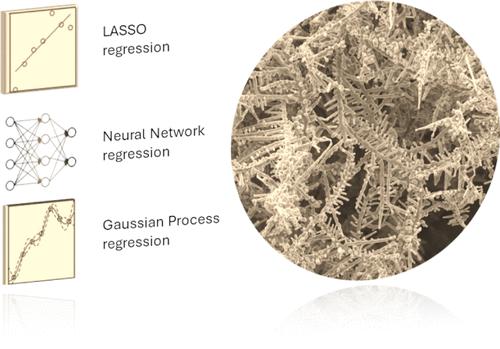当前位置:
X-MOL 学术
›
Chem. Mater.
›
论文详情
Our official English website, www.x-mol.net, welcomes your
feedback! (Note: you will need to create a separate account there.)
Machine-Learning-Driven Predictive 3D Ramified Foam Fabrication and Mechanistic Understanding
Chemistry of Materials ( IF 7.2 ) Pub Date : 2024-11-03 , DOI: 10.1021/acs.chemmater.4c01790 Yifei Liu, Donglei Emma Fan
Chemistry of Materials ( IF 7.2 ) Pub Date : 2024-11-03 , DOI: 10.1021/acs.chemmater.4c01790 Yifei Liu, Donglei Emma Fan

|
Hierarchical nanosuperstructures, ubiquitously found in nature, present dually enhanced mass transport and interfacial chemical reactions due to their unique 3D cascading features. Their man-made counterparts have demonstrated meritorious benefits toward electrocatalysis, flexible supercapacitors, and water disinfection. However, fabricating 3D superstructures with accurate structural characteristics remains exhaustive and challenging due to a multitude of variables in both experimental conditions and structural features. In this work, we explore three machine learning (ML) methods─linear regression, neural network regression, and Gaussian process regression─and, for the first time, realize accurate predictive fabrication of designed 3D microbranched foams by using a small training data set. Our findings demonstrate an advantageous accuracy of Gaussian process regression of over 87% across all benchmarks. We also effectively unravel the weighted roles of various experimental conditions, shedding light on the synthetic mechanisms. Overall, this work represents a new advance in the ML-enabled predictive fabrication of complex structures and materials with mechanistic elucidation.
中文翻译:

机器学习驱动的预测性 3D 分支泡沫制造和机理理解
分层纳米超结构在自然界中无处不在,由于其独特的 3D 级联特征,呈现双重增强的质量传递和界面化学反应。它们的人造对应物在电催化、柔性超级电容器和水消毒方面显示出卓越的优势。然而,由于实验条件和结构特征的众多变量,制造具有精确结构特性的 3D 超结构仍然很详尽且具有挑战性。在这项工作中,我们探索了三种机器学习 (ML) 方法——线性回归、神经网络回归和高斯过程回归——并首次通过使用小型训练数据集实现了设计的 3D 微分支泡沫的准确预测制造。我们的研究结果表明,高斯过程回归在所有基准中的准确性都超过 87%。我们还有效地揭示了各种实验条件的加权作用,阐明了合成机制。总体而言,这项工作代表了通过机理阐明对复杂结构和材料进行 ML 预测制造的新进展。
更新日期:2024-11-03
中文翻译:

机器学习驱动的预测性 3D 分支泡沫制造和机理理解
分层纳米超结构在自然界中无处不在,由于其独特的 3D 级联特征,呈现双重增强的质量传递和界面化学反应。它们的人造对应物在电催化、柔性超级电容器和水消毒方面显示出卓越的优势。然而,由于实验条件和结构特征的众多变量,制造具有精确结构特性的 3D 超结构仍然很详尽且具有挑战性。在这项工作中,我们探索了三种机器学习 (ML) 方法——线性回归、神经网络回归和高斯过程回归——并首次通过使用小型训练数据集实现了设计的 3D 微分支泡沫的准确预测制造。我们的研究结果表明,高斯过程回归在所有基准中的准确性都超过 87%。我们还有效地揭示了各种实验条件的加权作用,阐明了合成机制。总体而言,这项工作代表了通过机理阐明对复杂结构和材料进行 ML 预测制造的新进展。


















































 京公网安备 11010802027423号
京公网安备 11010802027423号